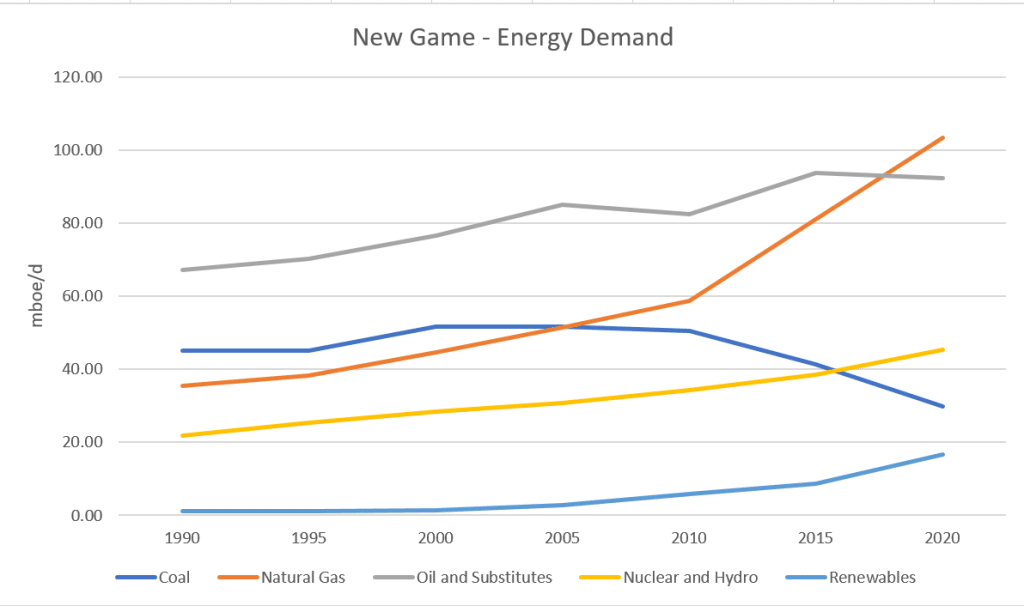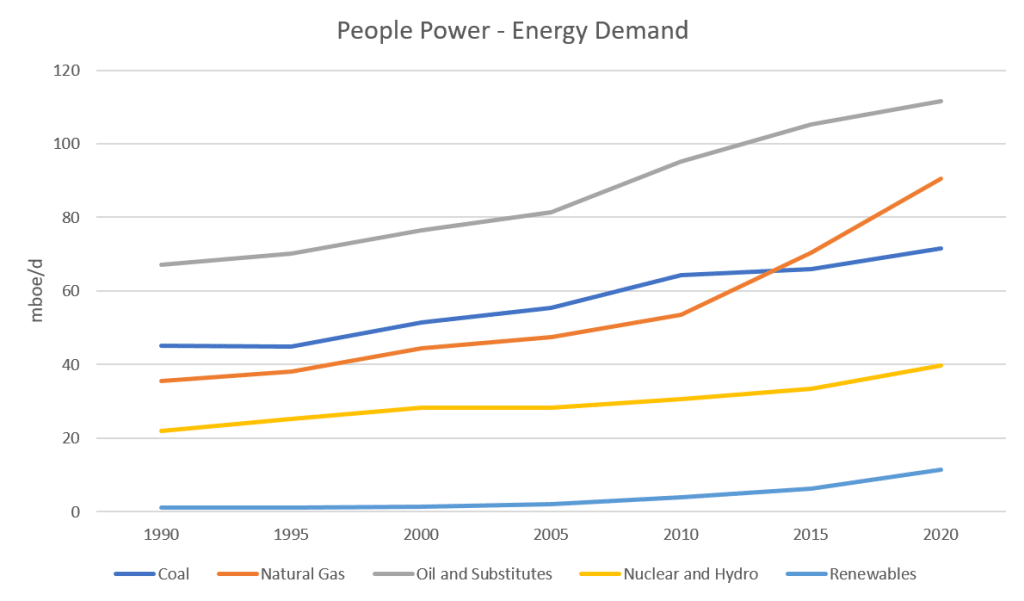In 1995 Royal Dutch/Shell Group (“Shell”) initiated a scenario planning process to examine how the company should respond to the forces of globalization, liberalization, and technology. The resulting internal reports, first published in 1998, have now been unearthed by Jelmer Mommers of De Correspondent. Named “TINA” for “There is no alternative” the scenarios anticipate changes in energy consumption, technology, social cohesion, and markets. This is a follow up from a similar exercise from a few years prior and a precursor to Shell’s recent “Sky,” “Mountain,” and “Oceans,” energy outlooks.
The 1998 documents focus on two primary scenarios: The New Game and People Power. Under The New Game, institutions remain strong and adapt to the changing world. While growth continues, environmental management results in a more rapid decline of coal and a stagnant future for oil. “We can scarcely believe we once thought Kyoto wouldn’t succeed.”
In the People Power scenario, institutions struggle to reform and a series of shocks disrupt the market. However, the outcome remains positive. A new values-driven world emerges with heavy emphasis on reputation and firms’ ability to tailor to customers. Oil plays a more dominant role in energy demand.
A more detailed analysis of assumptions, modeling, and subsequent actions is necessary for each model. However, a few key items stand out.
Shell applies the logic of a carbon budget to its analysis of remaining oil, gas, and coal reserves. The company concludes that existing known reserves of oil and gas can be consumed while staying within carbon limits. Coal reserves, however, push humanity past the budget. Note, Shell’s budget locates an acceptable carbon threshold at 650ppm; the chart reveals that use of existing gas or oil reserves would be enough to push us past 400ppm.
Shell foresees public concern over CO2, growing NGO presence, and advancements in car technology playing a significant role in shifting global oil prices.
Seemingly clairvoyant, Shell predicts a “series of violent storms” hitting the eastern coast of the United States. “Following the storms,” the authors continue, “a coalition of environmental NGOs brings a class-action suit against the US government and fossil-fuel companies on the grounds of neglecting what scientists (including their own) have been saying for years: that something must be done. A social reaction to the use of fossil fuels grows, and individuals become ‘vigilante environmentalists’ in the same way, a generation earlier, they had become fiercely anti-tobacco. Direct-action campaigns against companies escalate. Young consumers, especially, demand action …”
The TINA documents include two energy demand models under the New Game and People Power scenarios. Both predict an aggressive growth path for natural gas and declining coal consumption, with slightly different outlooks for oil.
The Volume 1 supplement focuses on “the function of corporations, the importance of strategic control points, the profit zone, the forces of atomisation and commoditisation, the nature of reputation, organisational learning, leadership, and core purpose.” Intended to inform stakeholder workshops, keynote speeches, and summary materials, the report attempts to answer a series of questions: whether Shell will “strengthen global institutions, continually reinvent our businesses, and learn to play The New Game? Or will [individual people], with [their] spontaneous, unstructured, and less predictable forces of wealth, choice, and education, dominate? Will consumer choice, rising personal expectations, and grassroots pressure groups overwhelm attempts to impose rules and overshadow old institutions?”
Volume 1 attempts to answer these questions by reckoning the “relentless search for profit” with the increase in NGOs focused on the environment in The New Game scenario. The authors realize the “significant number of customers … intensely concerned with the environmental or social impacts of their energy sources.” Noting that “these customers demand action,” Shell inventories lower carbon supply options.
“Volume 2 is a companion volume to Group Scenarios 1998-2020. It shows how the two scenarios develop in selected regions of the world. It also quantifies the global economic and energy implications of the two scenarios.”
Interested in more Shell documents? Full index here.





Pingback: In 1998, Shell Predicted It Would Be Sued Over Climate Crisis Someday – Huffington Post
Pingback: Taking a Leaf Out of Thoreau's Book | New York Times Climate FWD